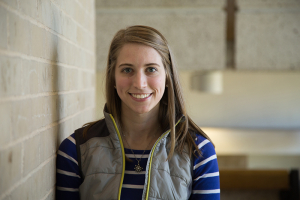Doctoral student Megan Ketchum received the Best Presentation Award of the “Chemical Engineers in Medicine” session at the 2015 American Institute of Chemical Engineers (AIChE) Annual Meeting held in Salt Lake City, UT last November.
The AIChE Annual Meeting is the premier educational forum for chemical engineers interested in innovation and professional growth. Academic and industry experts convene to cover a wide range of topics relevant to cutting-edge research, new technologies and emerging growth areas in chemical engineering.
During the meeting’s “Chemical Engineers in Medicine” session, Ketchum presented her paper titled “High-Throughput Biomimetic Assay Designed to Quantify Antimalarial Efficacy.” The session focused on diagnostics, treatments and theranostics and drew leading pharmaceutical industry and academic experts to its audience.
Malaria is a parasite that attacks a host’s red blood cells and can lead to fever, nausea, coma and even death. When a human host in infected, the host’s hemoglobin breaks down into several highly unstable heme molecules, which in turn oxidize to hematin. Hematin is naturally toxic to the parasite; however, the parasite responds by sequestering the hematin into crystals, rendering the hematin benign. Current antimalarial drugs work by inhibiting hematin crystallization, so that the parasite is unable to survive and is thus eradicated from the body.
At the Cullen College, Ketchum worked with faculty advisors Peter Vekilov and Jeffrey Rimer and fellow chemical and biomolecular doctoral student Katy Olafson to study the environment for this crystallization process.
When a person is infected with malaria, the parasite invades red blood cells. Within the digestive vacuole of the parasite are two components, one aqueous and one lipid. Ketchum and Olafson studied the solubility of hematin in both of these environments, ultimately determining that the lipid environment is better suited for crystallization. While there is a high volume of published research exploring crystallization in the aqueous environment, there is relatively little research done in lipid-like environments.
Though current antimalarial drugs are effective, the parasite is becoming resistant to these drugs and it’s taking longer for the parasite to leave the human body in many new cases. Because of this, Ketchum said, there is a dire need to create new drugs.
“This is really the driving force behind what we’re doing,” she said. “We’re creating a platform for designing new drugs.”
Ketchum is on track to graduate in December of 2016. Until then, she said she plans to continue her research in Rimer’s lab, expanding her focus to cholesterol crystallization in gallstones and arteries.
Ketchum said she was drawn to chemical and biomolecular engineering because she always liked the idea of helping people.
“I often wonder about ways I can help make things better, especially ways to improve treatment options and patients’ lives,” she said.
